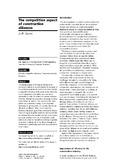Please use this identifier to cite or link to this item:
http://hdl.handle.net/10311/344Full metadata record
| DC Field | Value | Language |
|---|---|---|
| dc.contributor.author | Ngowi, A.B. | - |
| dc.date.accessioned | 2009-07-03T10:10:04Z | - |
| dc.date.available | 2009-07-03T10:10:04Z | - |
| dc.date.issued | 2001 | - |
| dc.identifier.citation | Ngowi, A.B. (2001) The competitive aspect of construction alliances. Logistics information management. Vol.14 No. 4, pp. 242-249 | en_US |
| dc.identifier.issn | 09576053 | - |
| dc.identifier.uri | http://hdl.handle.net/10311/344 | - |
| dc.description.abstract | The primary purpose of forming alliance in the construction industry is to pool together the resources of the participating partners in order to form a team that has a competitive advantage. Each partner in an alliance has its own competence and market share that do not necessarily fall under the alliance as common resources. Therefore, although the competitive advantage aimed at when forming an alliance is for common profits, each partner has a possibility of using it (the competitive advantage) for private profits (i.e. activities that do not fall under the alliance). Using a case study from Botswana, this paper argues that a construction alliances strives as long as the profits created by common activities are substantially higher that the ones that can be created by private activities. Once one of the partners in the alliance can create the competitive advantage in question on its own, it will opt out of the alliance through such mechanisms as withdrawing some of its key contributions to the alliance. | en_US |
| dc.language.iso | en | en_US |
| dc.publisher | MCB University Press. http//:www.emerald.library.com/ft | en_US |
| dc.subject | Alliances | en_US |
| dc.subject | competitive advantage | en_US |
| dc.subject | construction industry | en_US |
| dc.subject | Botswana | en_US |
| dc.title | Competition aspect of construction alliances | en_US |
| dc.type | Published Article | en_US |
| Appears in Collections: | Research articles (Dept of Civil Engineering) | |
Files in This Item:
| File | Description | Size | Format | |
|---|---|---|---|---|
| Ngowi_2001_JEIMngt.pdf | Main article | 1.16 MB | Adobe PDF |  View/Open |
Items in DSpace are protected by copyright, with all rights reserved, unless otherwise indicated.
